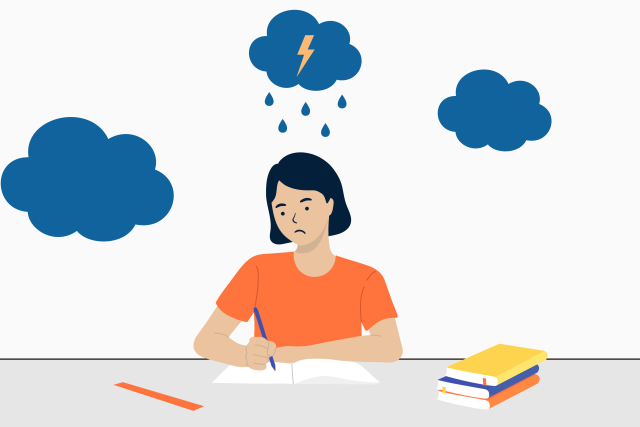It’s the morning before an exam. Your student has been preparing for this test for weeks, skipping social events and family dinners. They’re definitely prepared, in fact, they may be overprepared.
Yet, when they sit down for the exam, their mind goes blank, their heart starts racing, and they forget to put down their own name. These aren’t just normal nerves, they’re a sign of test anxiety.
Test anxiety is a type of academic anxiety, which is “an overwhelming stress around academic achievement,” says Kate Sheehan, LCSW, managing director of the UCLA Center for Anxiety, Resilience, Education and Support (CARES).
Your student is far from alone. A recent study in the Journal of School Psychology found test anxiety to be a highly common experience for students across ages and cultures, with potential negative effects for their learning outcomes later on.
However, test anxiety is addressable, and you can begin to support your student by first recognizing its signs.
Recognizing the signs
Test anxiety can present itself in your student’s physical wellness, ability to think and their behavior. And academic anxiety affects younger students just as much as it affects high school and college students.
“A lot of times, young kids will have frequent stomach aches, and they go to the pediatrician again and again to have it explained. It could be anxiety because our stomach is really linked to our fight-flight-freeze response.”
The signs can also affect behavior. Irritability, procrastination, laziness and avoidance are all common, says Sheehan.
“A lot of kids are actually so worried about their homework that they can't find a place to start, and then it looks like they just don't care. But actually, they care a lot.”
Parents can help prepare their students to manage test anxiety before, during and after the exam, Sheehan says.
Before the test
Preparation is key to reducing the anxiety of tackling an exam. Here are recommendations to share with your student.
First, it is helpful to set a realistic expectation for how much they need to perform. Students with anxiety often go into exams thinking they will fail, the worst-case scenario.
The brain leans on this “negativity bias,” causing us to pay more attention to problems than things that are going well.
Going over the worst case scenario beforehand can be useful. In this process, students may find that the catastrophe they’re imagining isn’t so catastrophic after all.
This comes up often with the students Sheehan works with. “If the worst-case scenario includes getting a 60, they just need the mindset of ‘I just need 15-20 points on top of that.’”
During the test
Encourage your student when beginning an exam to create a clear roadmap and start with what they know.
“Sit down, put your name on the test,” says Sheehan. “Congratulations, you’ve already done one thing you know!”
It’s also helpful to break the exam down into smaller portions. If they have 30 questions to tackle, they can draw lines between each set of ten and answer them section by section.
On occasion, physical anxiety may get in the way of students remembering what they know, Sheehan says.
“When they get anxious, their body turns to fight-flight-freeze mode. Their heart may race, their breaths may become shorter, their vision may narrow and their digestion may shut down to put all of their energy into survival.”
It’s much more difficult to access your memory in this state, Sheehan explains. Anxious thoughts tend to play on a loop in your brain, interrupting your thinking and efforts to demonstrate and access your knowledge.
Anxiety tends to wind the body in a circular feedback loop. “What we want is to unwind it in the opposite direction,” says Sheehan.
It is helpful for students to practice relaxation techniques they can employ during the exam. Practicing beforehand helps them kick in automatically, Sheehan says: “Like when you get in a car, you will put your seat belt on automatically because you’re reminded again and again over the years.”
Students should think about what part of their body holds the most tension, whether it’s the brows, the neck or shoulders, Sheehan says. Every time they check the clock, they can try raising and lowering their shoulders to allow their body to reset.
“When they start, they can take a breath and try to hold the exhale just a second longer than they usually would. Shifting their focus to their exhale and counting to two automatically lets them inhale more deeply. “
After the test
After the exam is a rich time for parents to step in as cheerleaders and potential problem-solvers, says Sheehan.
Talk with your student about what went well, what went wrong, and what they can improve on for the next time. It will help them narrow down and verbalize their sources of anxiety.
“Parents can correct whatever story is happening in the kid’s head if we get them to say it out loud. If they don't say it out loud, we never know what story they're telling themselves.”
When to seek further guidance
If your student frequently experiences symptoms of intense anxiety during or long after the test, it may be a sign to seek further medical advice.
The CARES Center publishes fact sheets for parents, teachers and students with tips to recognize and face the concerns of test anxiety. You can learn to recognize these signs and address them inside and outside the classroom. Read the fact sheets. and watch a tutorial on recognizing anxiety in the classroom.
Maanasi Kademani is the author of this article.



